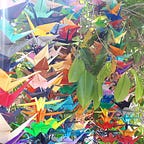Deep Ecology Practice: Grounding
Grounding is a practice of becoming aware of the Earth’s support and drawing strength from it
--
Right now, your body is supported by the Earth. Even if this is indirect, through a chair or a bed or a surface several floors above ground, all ultimately rest upon the Earth. The support speaks to your feet, hips, spine and skull. It wraps your muscles and organs. Gravity holds you. You are always welcomed by the Earth.
Wendell Berry wrote, ‘the world cannot be discovered by a journey of miles, no matter how long, but only by a spiritual journey, a journey of one inch, very arduous and humbling and joyful, by which we arrive at the ground at our own feet, and learn to be at home.’ [1]
Noticing the ground, you take this one-inch journey.
Attending deeply to the experience of groundedness, in stillness, nourishes a sense of security and peacefulness. We do not merely move or rest upon the ground. We are Earth.
Deep Ecology recognises that this Earth is our true and only home. It is our greater Self. We are as a leaf upon an immense and beautiful tree, a small part of something alive and precious.
What brings groundedness alive for you? Step-after-step walking, digging a garden, cleaning the floor, flowing in Qi Gong, bread-making, care for a loved one? There are ways without count.
Think of the soil, which brings to life wildflowers and forests. Once you are grounded, what do you bring to life?
Practice: Grounding
Grounding is a practice of becoming aware of the Earth’s support and drawing strength from it. It can happen in any position, sitting or standing. In yoga grounding takes place in the asana and transitions between them, but there is no need for special exercises to notice the ground. The experience is accessible.
As you are, pause. Notice where you feel the weight of your body, and where you meet the Earth. Take refuge here. Feel into the relationship between your body and the ground, and find stability, perhaps even an embrace from the Earth. Be supported.
If it is comfortable and healthy for you, you could come to the yoga pose Balasana, child’s pose. Begin kneeling, then bring the hips to rest over the heels, and the forehead to the ground. The hands and arms may reach forward, or rest beside the body. This pose connects us with the Earth’s wisdom, bringing the space between the brows, the third eye, in contact with the ground. To be comfortable in child’s pose, some people prefer to have the knees wide apart and the toes touching, or to support the hips with a block or cushion. In order to rest some time in this position, cushion the forehead with a folded blanket.
Child’s pose brings the head below the heart, which encourages blood flow and is relaxing for many people. However, it is not suitable for everyone, so listen to your own body and consider if it is right for you. It should not be practiced by people with high blood pressure.
In whatever position you are sitting, feel the Earth’s contact and notice the body as a field of sensation, reaching 360 degrees around, above and below and to either side. Consider that your body, a field of sensation and awareness, is held by the Earth, a greater field of sensation and awareness.
There is no need to think about the Earth or nature, for we are ourselves the Earth’s thinking. We are nature dreaming, imagining, exploring, moving. The Earth is breathing us, and dreaming us. Grounded, allow Earth-thinking to flow through you.
You might ask, can I notice the Earth creating me, giving me life and acting through me? If she has a message for me, am I listening?
There is no need to force anything; simply allow yourself to be.
*
More deep ecology practices are listed at the end of this article. Follow me on Medium for updates.
[1] Wendell Berry, The Unforeseen Wilderness: Kentucky’s Red River Gorge (Shoemaker Hoard, 1991), p. 43.
